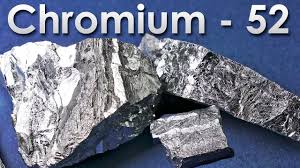Industrial Preparation of Chromium Metal
Chromium occurs in the minerals chromite, FeO•Cr2O3 and crocoite, PbCrO4. Chromium metal is produced by thermal reduction of chromium(III) oxide, Cr2O3 by aluminum, silicon or carbon. The starting material in all these thermal reduction processes are Cr2O3 which is obtained from the natural ore chromite after the removal of iron oxide and other impurities. In the aluminum reduction process, the oxide is mixed with Al powder and ignited in a refractory-lined vessel.
Chromium is produced industrially in three forms:
Ⅰ.ferrochrome, a master alloy of iron and chromium containing between 40 and 75 wt.% Cr and varying amounts of carbon and silicon;
Ⅱ.pure chromium metal;
Ⅲ.hromium chemicals (e.g., sodium chromate and dichromate, potassium dichromate, and chromium trioxide or chromic acid).

Industrial Preparation
Pure chromium metal is obtained commercially from the aluminothermic or silicothermic reduction of chromium sesquioxide, or chromia (Cr2O3), and to a lesser extent by electrowinning.
In the aluminothermic process, first the chromia is prepared by the soda-ash roasting of chromite ore. After mixing the raw chromite ore with sodium carbonate or soda ash (Na2CO3) and sometimes quicklime (CaO), the charge is calcined into a rotary kiln at 1100°C. The roasting yields the soluble sodium chromate (Na2CrO4) according to the following chemical reaction:
FeCr2O4(s) + Na2CO3(s) —> 2NaCrO4(s) + Fe2O3(s) + CO2(l).
The roasted clinker is then leached out with hot water and the resulting liquor filtered to remove insoluble silica, along with aluminum and iron oxides present as impurities in the original chromite ore. Pure sodium dichromate is then crystallized and dried. The anhydrous sodium chromate can then be reduced to chromium trioxide by simple carbothermic reduction. Once produced, chromium trioxide is mixed with aluminum powder and lime and placed inside a refractory-lined steel vessel. The exothermic reaction is started by igniting a pyrotechnic mixture made of barium peroxide and aluminum powder or potassium chlorate aluminum powder:
Cr2O3(s) + 2Al(s) —> 2Cr0(s) + Al2O3(s).
The aluminothermic process yields pure chromium metal (97 to 99 wt.% Cr), the major impurities being Al, Fe, C, and Si. Chromium metal can also be produced by the silicothermic process performed in a submerged-arc furnace to yield pure chromium metal with no aluminum but with 0.8 wt.% Si according to the following reactions:
2Cr2O3(s) + 3Si(s) —> 4Cr0(s) + 3SiO2(s).
Finally, chromium metal can be obtained by electrowinning from chromium-rich liquors by two electrochemical processes: chromium-alum electrolysis and chromic acid electrolysis. In chromium-alum electrolysis, the chromium-rich liquor is obtained by leaching high-carbon ferrochrome with recycled spent catholyte containing chromium alum [(NH4)Cr(SO4).12H2O] and makeup sulfuric acid. It contains ammonium chromium alum.
You may like
Related articles And Qustion
Lastest Price from Chromium manufacturers

US $10.00/KG2025-04-21
- CAS:
- 7440-47-3
- Min. Order:
- 100KG
- Purity:
- 99%
- Supply Ability:
- 100 mt

US $12.50-10.50/kg2025-01-16
- CAS:
- 7440-47-3
- Min. Order:
- 1000kg
- Purity:
- 99%
- Supply Ability:
- 1000ton/Year





